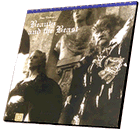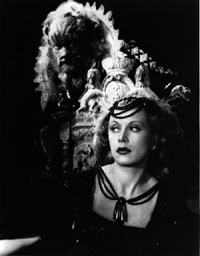

France film school
1946
bw 93 min.
Director: Jean Cocteau
CAV: $89.95 - available
2 discs, catalog # CC1245L
DVD: $39.95 - available
1 disc, catalog # BEA120
VHS: available from Home Vision Cinema
 Beauty and the Beast, the first film of Cocteau's own since
The Blood of a Poet, is by general consent one of the most
enchanting pictures ever made, and its production was one of those
undertakings that with a kind of general benevolence shed lustre on
all its participants. It brought new accolades to Madame Leprince de
Beaumont, the eighteenth-century author of the fairy tale. Jean Marais
had suggested the film: for him, his face masked by the fur and fangs
of the Beast, his body padded and swathed in velvet, his hands made
into claws, it was his triumph of acting over physique. Lovely Josette
Day played Beauty, the good country girl, with an intelligence and a
dancer's grace that Cocteau praised without reserve; and she, the
actresses who play her wicked sisters, and the rest of the cast are
outstanding in the way they speak, move, wear their clothes, and form
tableaux la Vermeer and Le Nain. The Gustave Dore sumptuousness of
Christian Berard's costumes and decor is reminiscent not in style, but
in spirit and success, of Bakst's lavishness in ballet. In Berard,
Cocteau had found a new fellow master of fantasy, an anti-modern,
neo-baroque successor to the Picasso of Parade; and the high
style of his famous perspective of human arms emerging from draperies
to grasp lighted candelabra that materialize in the air, the moving
eyes of his dusky, smoke-breathing caryatids, his pair of Louis XIV
marble busts of Turks, lend fantastic cinema a nobility that had been
previously hinted at -- one can only mention the earlier film again --
in The Blood of the Poet. Henri Alekan gave the photography
the tone Cocteau wanted, the "soft gleam of hand-polished old silver,"
particularly exquisite in the swaying, sheer white curtains, in
Beauty's tear that turns into a pearl. The most haunting feature is
Marais' beast mask, a remarkable creation, so appealingly beast-like
as to be more "becoming" than his lover's-postcard transfiguration as
Prince Charming at the end of the film. The idea of the film was hard
to sell to a producer, and although it became a professional and
commercial undertaking, with well-paid stars, jealous unions, watchful
insurance companies and budgeted financing by Gaumont, Beauty and
the Beast nevertheless represented a triumph over primary
difficulties. Like most of the combatant countries, France emerged
from the war stripped; Cocteau himself was receiving food packages
from Jean-Pierre Aumont in California, and when he fell ill he was
treated with American penicillin; everything was in short supply. Old
cameras jammed, old lenses developed flaws, no two batches of film
were alike, electric current failed or was bureaucratically cut off;
there was small choice of fabrics for costumes; sheets without patches
were sought everywhere for the farmyard laundry scene; the curtains of
Beauty's bed were stolen from the set.
Beauty and the Beast, the first film of Cocteau's own since
The Blood of a Poet, is by general consent one of the most
enchanting pictures ever made, and its production was one of those
undertakings that with a kind of general benevolence shed lustre on
all its participants. It brought new accolades to Madame Leprince de
Beaumont, the eighteenth-century author of the fairy tale. Jean Marais
had suggested the film: for him, his face masked by the fur and fangs
of the Beast, his body padded and swathed in velvet, his hands made
into claws, it was his triumph of acting over physique. Lovely Josette
Day played Beauty, the good country girl, with an intelligence and a
dancer's grace that Cocteau praised without reserve; and she, the
actresses who play her wicked sisters, and the rest of the cast are
outstanding in the way they speak, move, wear their clothes, and form
tableaux la Vermeer and Le Nain. The Gustave Dore sumptuousness of
Christian Berard's costumes and decor is reminiscent not in style, but
in spirit and success, of Bakst's lavishness in ballet. In Berard,
Cocteau had found a new fellow master of fantasy, an anti-modern,
neo-baroque successor to the Picasso of Parade; and the high
style of his famous perspective of human arms emerging from draperies
to grasp lighted candelabra that materialize in the air, the moving
eyes of his dusky, smoke-breathing caryatids, his pair of Louis XIV
marble busts of Turks, lend fantastic cinema a nobility that had been
previously hinted at -- one can only mention the earlier film again --
in The Blood of the Poet. Henri Alekan gave the photography
the tone Cocteau wanted, the "soft gleam of hand-polished old silver,"
particularly exquisite in the swaying, sheer white curtains, in
Beauty's tear that turns into a pearl. The most haunting feature is
Marais' beast mask, a remarkable creation, so appealingly beast-like
as to be more "becoming" than his lover's-postcard transfiguration as
Prince Charming at the end of the film. The idea of the film was hard
to sell to a producer, and although it became a professional and
commercial undertaking, with well-paid stars, jealous unions, watchful
insurance companies and budgeted financing by Gaumont, Beauty and
the Beast nevertheless represented a triumph over primary
difficulties. Like most of the combatant countries, France emerged
from the war stripped; Cocteau himself was receiving food packages
from Jean-Pierre Aumont in California, and when he fell ill he was
treated with American penicillin; everything was in short supply. Old
cameras jammed, old lenses developed flaws, no two batches of film
were alike, electric current failed or was bureaucratically cut off;
there was small choice of fabrics for costumes; sheets without patches
were sought everywhere for the farmyard laundry scene; the curtains of
Beauty's bed were stolen from the set.
The filming of Beauty and the Beast brought Cocteau an
enchantment reminiscent of his days with the Diaghilev troupe, the
sensation of being part of a hard-working family of sacred monsters;
moving from manor to ch‰teau to Paris film studio they were like
mountebanks; Cocteau's journal celebrates the camaraderie and good
will of the company -- the actors' professional tolerance of each
other's crises de nerfs, their busy shuttling between the film studio
and the legitimate theaters where some of them were simultaneously
appearing in plays, the combination of familiarity and respect shown
by the grips, their never failing improvisation when rescue was
needed, the studio sweepers' praise after the first rushes, the
Vouvray wine with the picnic meals, cast and crew playing cards during
rests.
After cutting, after the synchronization of Auric's music -- Auric
was the only veteran of The Blood of the Poet to collaborate on
Beauty and the Beast -- the first showing of the film for an
audience of any size was for the technicians in the Joinville
studio. The invitation was written on the studio blackboard; schedules
were changed to leave everyone free. Cocteau wrote in his journal,
"The welcome the picture received from that audience of workers was
unforgettable. It was my greatest reward. Whatever happens, nothing
will ever equal the grace of that ceremony organized very simply by a
little village of workmen whose trade is the packaging of dreams."
-- FRANCIS STEEGMULLER, from Cocteau: A Biography by Francis
Steegmuller
Credits
Writer/Director: Jean Cocteau
Producer: Andr Paulv
Production Director: Emile Darbon
Cinematography: Henri Alekan
Music: Georges Auric
Assistant Director: Christian Brard
Technical Advisor: Ren Clment
Costumes/Sets: Christian Brard
Editor: Claude Ibria
Sound: J. Lebreton
Transfer
This edition of Beauty and the Beast was transferred from a new
35mm print made from the finest negative materials known to
exist.





